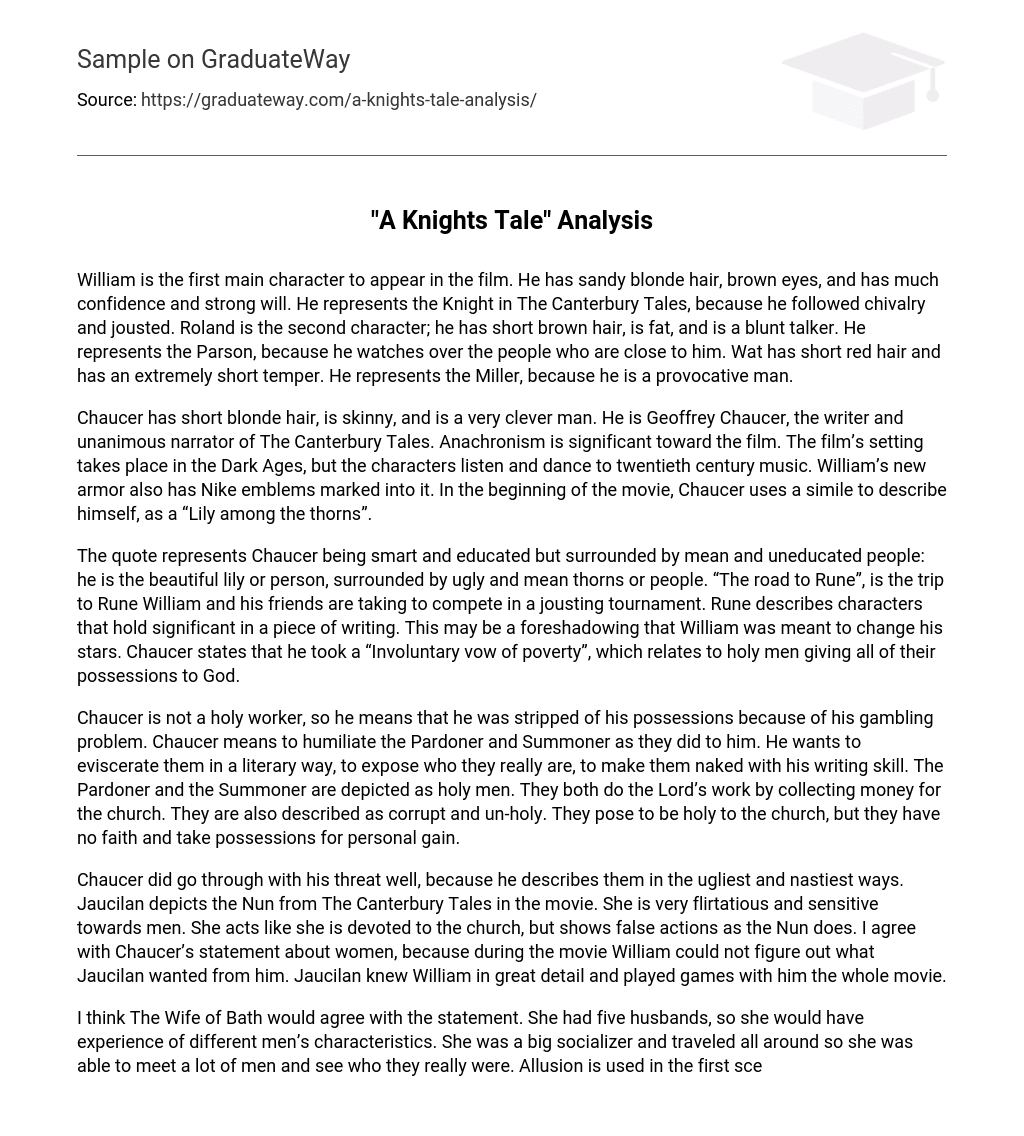William is the first main character in the film. He has sandy blonde hair, brown eyes, and exudes confidence and strong will. He symbolizes the Knight in The Canterbury Tales as he adheres to chivalry and engages in jousting. Roland is the second character, sporting short brown hair, a plump physique, and a frank speaking style. He embodies the Parson as he dutifully guards over those in his close circle. Wat, on the other hand, sports short red hair and an easily triggered short temper. He parallels the provocative nature of the Miller.
Chaucer, the writer and narrator of The Canterbury Tales, is described as a very clever man with short blonde hair and a skinny build. Anachronism plays a significant role in the film as it is set in the Dark Ages but features characters listening and dancing to twentieth century music. Additionally, William’s new armor includes Nike emblems. In the opening of the movie, Chaucer compares himself to a “Lily among the thorns” using a simile.
The quote represents Chaucer’s intelligence and education in contrast to the mean and uneducated people around him. He compares himself to a beautiful lily surrounded by ugly and mean thorns. “The road to Rune” refers to the journey that Rune William and his friends are undertaking for a jousting tournament. Rune explains that characters play a significant role in a piece of writing, possibly hinting that William was destined to change his fate. Chaucer mentions taking an “Involuntary vow of poverty,” which parallels the act of holy men giving up all their possessions for God.
Chaucer, not being a holy worker like the Pardoner and Summoner, believes that his own loss of possessions can be attributed to his gambling problem. Chaucer seeks to shame and demean the Pardoner and Summoner in return, desiring to expose their true nature through his writing prowess. Both the Pardoner and Summoner are portrayed as individuals who carry out religious duties, such as collecting funds for the Church. However, they are also depicted as corrupt and lacking in holiness. While appearing devout to the Church, their actions reveal a lack of faith as they prioritize personal gain by taking possession of items.
Chaucer carried out his threat effectively by portraying the characters in the most unattractive and repulsive manner. In the film adaptation of The Canterbury Tales, Jaucilan represents the Nun character. She behaves in a seductive and vulnerable way towards men, pretending to be devoutly religious but ultimately engaging in deceitful actions, just like the Nun. I concur with Chaucer’s viewpoint on women because throughout the movie, Jaucilan intentionally confuses William’s understanding of her intentions. Jaucilan possesses an extensive knowledge of William and manipulates him throughout the entire film.
The Wife of Bath, who had five husbands, would likely agree with the statement as she had experience with different men’s characteristics. Being a social individual and a traveler, she had the opportunity to meet numerous men and gain insight into their true nature. In the first scene of the story, an allusion is made when William, as a young boy, watches knights pass by on the street with his father. William asks his father if he can also become a knight, to which his father responds, “any man can change his stars.”
William finds motivation in his father’s words and ultimately transforms his fate, becoming a knight. Chaucer, an insightful individual, reflects on his life experiences through writing, fully utilizing his craft. He believes in the limitless potential of authors and artists to document and reveal various aspects of life. Valuing every detail of events, he aims for perpetual remembrance.
A true artist uses various means to depict the occurrences in life and create illustrations of possible events. In my opinion, Chaucer successfully achieved this objective. He managed to document his experiences during his travels and portray the individuals he encountered in vivid detail. In his accounts, Chaucer presents a comprehensive depiction of the pilgrims, revealing their personalities and true natures. While initially appearing genuine, many of these characters are revealed to be deceitful and corrupt from Chaucer’s perspective. As the story progresses and Chaucer delves into the actions of these pilgrims, the reader’s perception undergoes a transformation.





